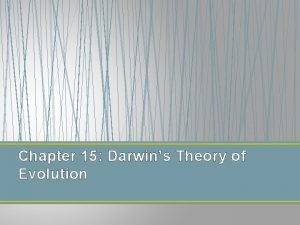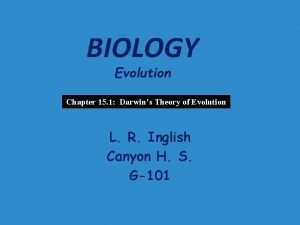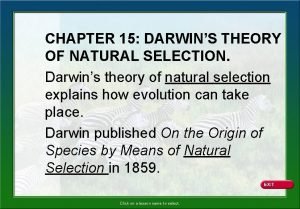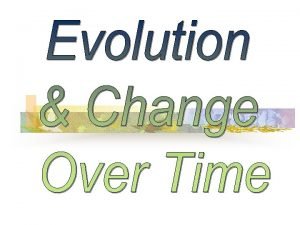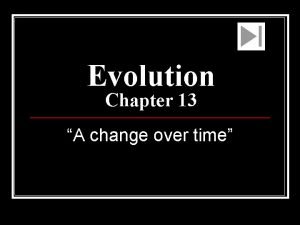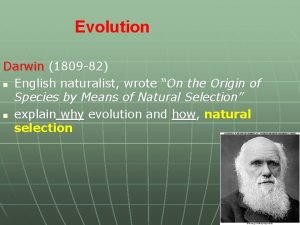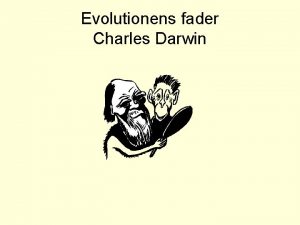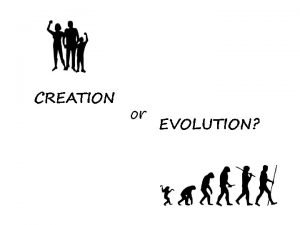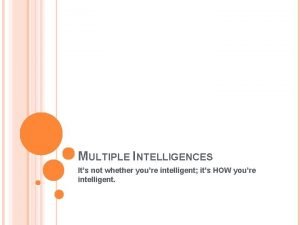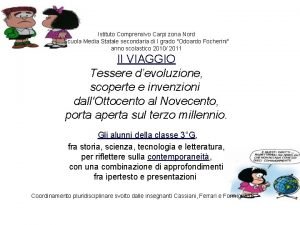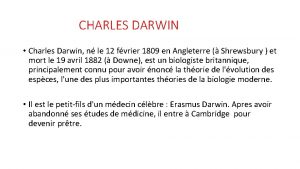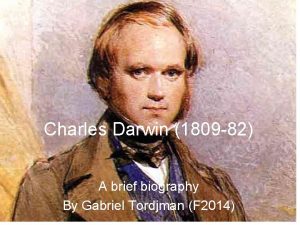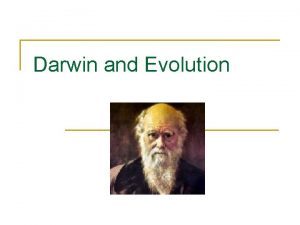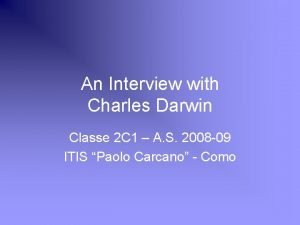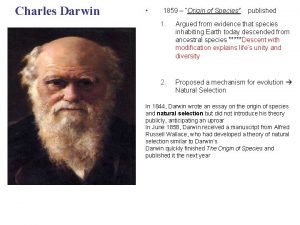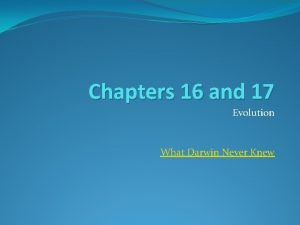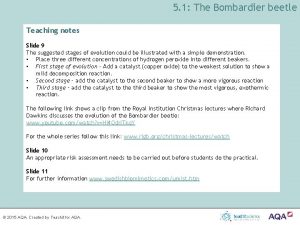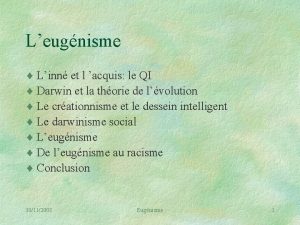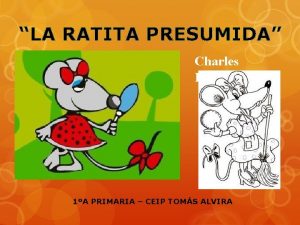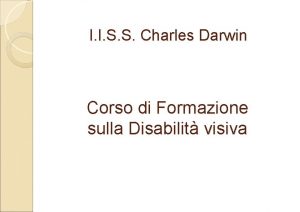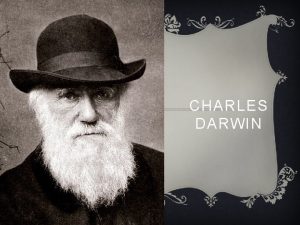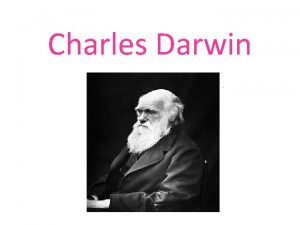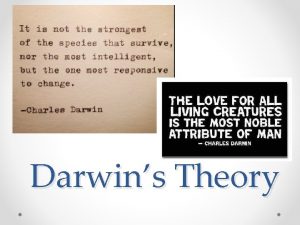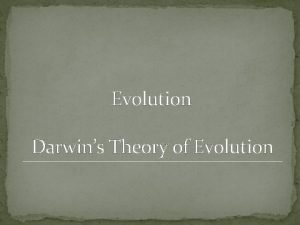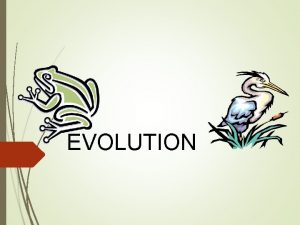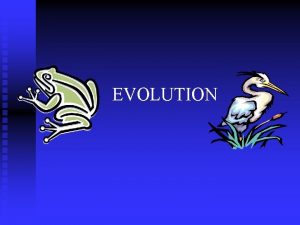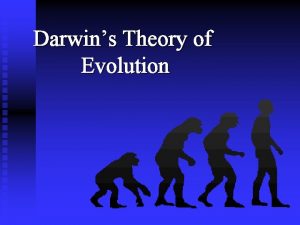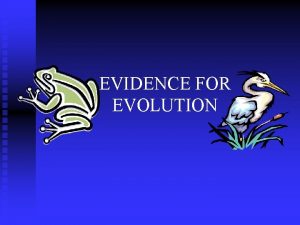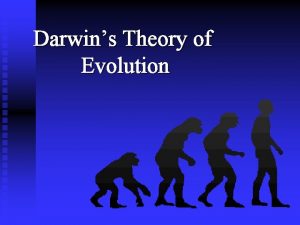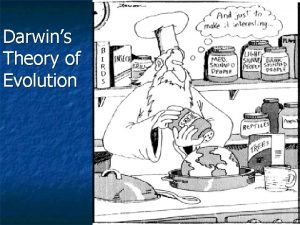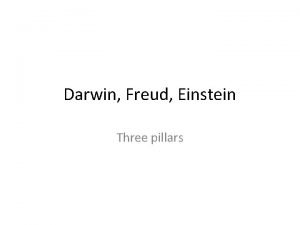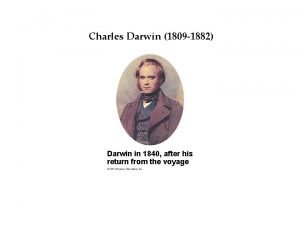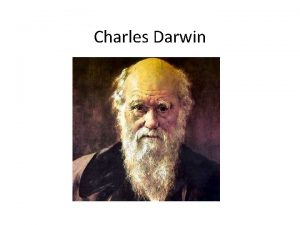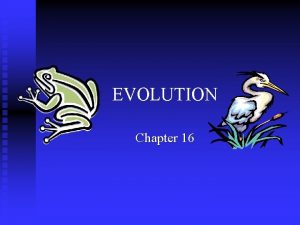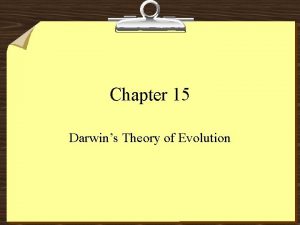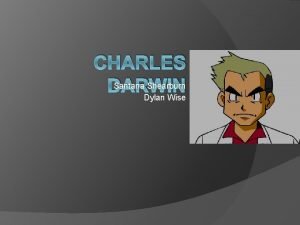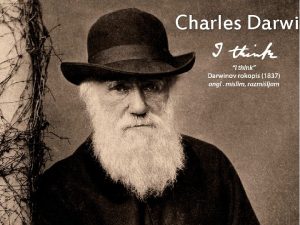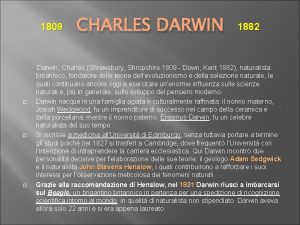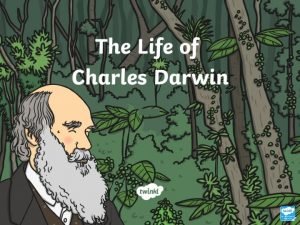Darwins Theory of Evolution Charles Darwin Darwins Theory




























- Slides: 28

Darwin’s Theory of Evolution

Charles Darwin

Darwin’s Theory of Evolution Species change over time as they adapt to their changing environment

Evolution is the process by which species change over time • Charles Darwin’s theory of evolution most commonly accepted • First set out in his book On the Origin of Species (1859).

Darwin’s Trip to Galapagos Islands • On HMS Beagle (1831) • Islands in Pacific Ocean off coast of South America • Darwin made observations that led to theory.

Voyage of the Beagle



Darwin’s Observations • Animals/Plants are very well adapted to environment • Some fossils look like present day animals- some looked like nothing seen before

Darwin’s Observations • Even though they were all very close, the different islands of Galapagos had very different climates and habitats • Had different animals as well

Darwin’s Finchesadapted for different environments/niches

New Ideas in Science that lead to Darwin’s Theory: • Earth is millions or even billions of years old • Features of earth have changed

Darwin’s Theory • Species have natural variation- not all look the same • Members of species compete for food, water, etc. • Survival of the fittest (Natural Selection).

Darwin’s Theory • Natural Selection leads to changes in the way a population looks. • Populations change over time as they adapt to their changing environment

HOW DOES EVOLUTION HAPPEN? • Evolution occurs by Natural Selection • Natural Selection is a process in which organisms with favorable traits survive and reproduce at a higher rate than those without the favorable trait.

NATURAL SELECTION • Natural Selection determines the survival of groups of organisms HOW? • Desirable traits are passed-on to offspring • Traits that make organisms better equipped to survive the environment, will survive to reproduce and pass these traits on to their offspring. This is Charles Darwin’s “Survival of the Fittest”

Descent with Modification • Natural selection changes what a population looks like. • As a result, species today look different than their ancestors.

Evidence of Evolution • Fossils- shows change in species over time • Geographic distributionanimals in different places look different, but animals in same types of environment look similar (convergent evolution)

Which is Dingo? Which is Dog?

Fossil Evidence

Evidence of Evolution • Homologous structures that look different, but have same origins • Similarities in early development

Homologous Body Structures The limbs and digits (fingers and toes) of many mammals are adapted to their particular way of life. Note the variety of lengths and shapes of the limb bones. Homologous bones are the same color in all the drawings. Monkey Horse Mole Bat Seal

Homologous Structures:

Similarities in early development • Embryos of vertebrates are similar

Mouse and Chicken Embryos

Similarities in DNA • DNA from closely related species have greater similarities in their DNA than species that appear to be distant relatives

Similarities in DNA

Quiz 1. How did the fossils Darwin observed compare with the living organisms he studied? 1. Some fossils look like present day animals- some looked like nothing seen before 2. What are three important observations Darwin made while on his voyage of the world and the Galapagos? 1. 2. 3. 4. Plants & animals were well adapted to their environment Some fossils look like present day animals- some looked like nothing seen before. The islands of the Galapagos all had different climates & habitats. The islands also had different animals.
 Explain the theory of evolution
Explain the theory of evolution Www.bf.tku.edu.tw/files/news chapter 17
Www.bf.tku.edu.tw/files/news chapter 17 Chapter 15 darwin's theory of evolution
Chapter 15 darwin's theory of evolution Chapter 15 darwin's theory of evolution section 15-1
Chapter 15 darwin's theory of evolution section 15-1 Homologous structures definition biology
Homologous structures definition biology Chapter 15 darwin's theory of evolution
Chapter 15 darwin's theory of evolution What does darwin's theory of evolution suggest?
What does darwin's theory of evolution suggest? Endosymbiont theory
Endosymbiont theory Darwin and evolution
Darwin and evolution Vem var charles darwin
Vem var charles darwin Worldview academy
Worldview academy Where was charles darwin born
Where was charles darwin born Celebrities with spatial intelligence
Celebrities with spatial intelligence Charles darwin origine della specie
Charles darwin origine della specie Giustificazione dello schiavismo versione greco
Giustificazione dello schiavismo versione greco Charles darwin vikidia
Charles darwin vikidia Where was charles darwin born
Where was charles darwin born Charles darwin notes
Charles darwin notes Definition of chronemics
Definition of chronemics Charles darwin
Charles darwin Darwin
Darwin Vestigial structures
Vestigial structures Charles darwin
Charles darwin Bombardier beetle life cycle
Bombardier beetle life cycle Darwin vs lamarck
Darwin vs lamarck Qi de darwin
Qi de darwin Dialogo de la ratita presumida
Dialogo de la ratita presumida Isis charles darwin
Isis charles darwin Origin of species by charles darwin
Origin of species by charles darwin



